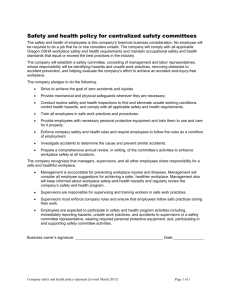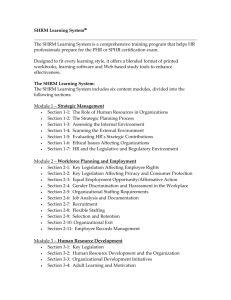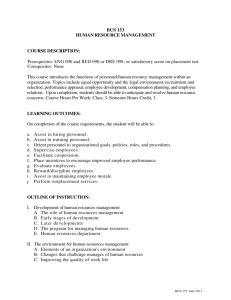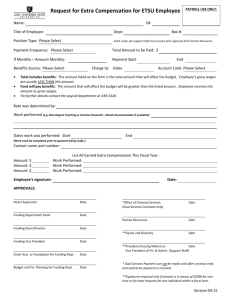Benefits - Learning Management System
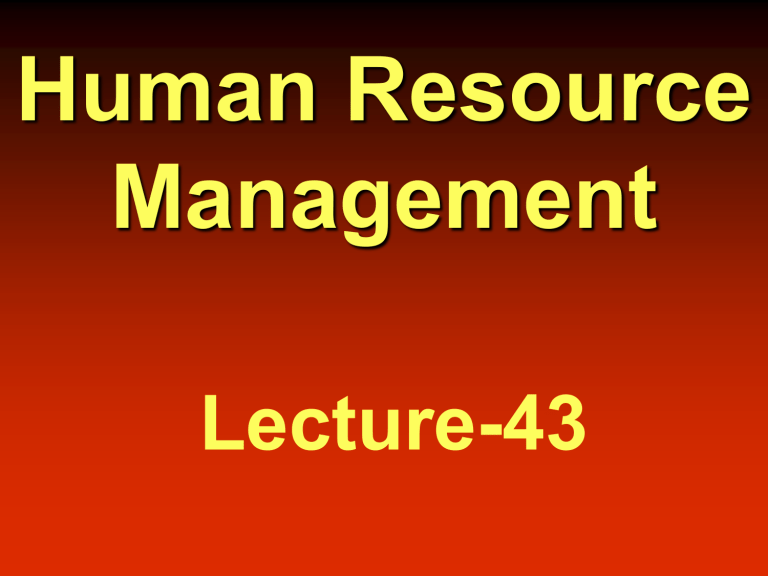
Human Resource
Management
Lecture-43
Staffing
Employee
& Labor
Relations
HRM
FUNCTIONS
Human
Resource
Development
Safety &
Health
Compensation
& Benefits
Job
Evaluation
Process for ensuring internal equity (jobs of comparable worth receive comparable wages)
So…..
The comparison results in a wage or salary hierarchy
Choosing a Job
Evaluation
Method
There are four general job evaluation methods.
Ranking
Classification
Factor comparison
Point factor
Job Pricing
Job Analysis
Job Evaluation Pay Surveys
Pay
Policie s
Pay Structure
Individual Pay
Performance
Appraisal
Implementation, Communication,
Monitoring
Compensation system
Compensation of
Employees
Extrinsic
Rewards
Hourly Wages
Salary
Monetary Bonuses
Rewards Commissions
Pay Incentives
Insurance
Retirement
Paid Vacations
Benefits Food Services
Credit Union
Recreation
Intrinsic
Rewards
Recognition
Promotion Opportunities
Working Conditions
Interesting Work
Strategic Role of
Benefits
Benefits absorb social costs for health care and retirement.
Benefits influence employee decisions about employers (e.g., recruitment and retirement).
Benefits are increasingly seen as entitlements.
Benefit costs are about 40% of total payroll costs.
Types of
Benefits &
Services
Insurance Benefits
• Medical Insurance
• Vision Insurance
• Dental Insurance
• Mental Health Insurance
• Life Insurance
• Disability Insurance
Employee Security Benefits
• Employment Income Security
• Retirement Security
Time-Off Benefits
• On-the-job Breaks
• Sick Days Pay
• Holidays & Vacations
• Leaves of Absence
Work Scheduling Benefits
• Shorter Work Times
• Flextime
• Job Sharing
Employee Services
•
Educational Assistance
• Financial Services
• Social Services
Family Oriented
• Child Care
• Elder Care
• Relocation Programs
Other Benefits
Purchase
Discounts
Stock Investment
Family-Care
Benefits
Relocation
Expenses
Family-
Oriented
Benefits
Social and
Recreational
Benefits
Life, Disability,
Legal
Insurances
Educational
Assistance
Other Employee
Benefits and
Services
Awards
Recreational and Social
Credit
Purchasing
Assistance
Transportation
Pooling
Food Services
On-Site Health
Services
Legal Services
Housing and
Moving
Financial
Planning
Pay-for-
Performance
A compensation philosophy of higher pay for higher contributions
Performance will be calculated on - corporate performance and personal performance .
Types of Payfor-Performance
Plans
Individual-Based plans
• Merit Pay
• Bonus program or lumpsum payment
• Award
Team-Based plans
Plant-wide plans (gain sharing)
Corporate-wide plans
(profit sharing)
The Role of
Money
When someone says, “It’s not the money, it’s the principle, it’s the money!
-- Anonymous
Money as a Motivator
Rewards and other Employee
Behaviors
Turnover
Rewards
Absenteeism
Attendance
Staffing
Employee
& Labor
Relations
HRM
FUNCTIONS
Human
Resource
Development
Safety &
Health
Compensation
& Benefits
Health & Safety
Occupational health & safety refers to the physiological-physical and psychological conditions of a workforce that result from the work environment provided by the organization.
Elements of
Workplace Safety and Health
Physical Conditions:
– Conditions resulting from the workplace environment that include occupational diseases and accidents, such as:
• Repetitive motion injuries
• Back pain
• Cancer
• Etc.
Occupational diseases & accidents
Loss of life
Loss of limb
Back pain
Cardiovascular disease
Various forms of cancer
Psychological Conditions:
– Conditions resulting from the workplace environment that result from organizational stress and low quality of working life.
These include:
• Dissatisfaction, withdrawal
• Mistrust in others, irritability
Causes of
Accidents
Unsafe conditions
– Physical conditions
• defective equipment
• inadequate machine guards
• lack of protective equipment
– Environmental conditions
• Noise
• dust, fumes
• stress
Unsafe behaviors
Causes of Accidents
Human
– Overwhelming majority
– Carelessness
– Intoxication
– Daydreaming
– Inability to do the job
– Other human deficiency
Steps to Take to
Reduce Workplace
Accidents
Reduce unsafe conditions.
Reduce unsafe acts.
Use posters and other propaganda.
Provide safety training.
Use positive reinforcement.
Emphasize safety.
Establish a safety policy.
Set specific loss control goals.
Conduct safety and health inspections regularly.
Monitor work overload and stress.
Safety committees.
Violence Prevention Suggestions
Develop a plan
Review policies
Treat with respect and dignity
Problems occur
– Disciplined too harshly
– Laid off without reason
What is Stress?
Stress is an adaptive response, moderated by individual differences, that is a consequence of any action, situation, or event that places special demands on a person.
A Model of Stress
Potential Sources
Environmental
Factors
Organizational
Factors
Individual
Factors
Individual
Differences
Experienced
Stress
Consequences
Psychological
Symptoms
Physiological
Symptoms
Behavioral
Symptoms
Is stress good or bad?
Stress Management and
Prevention
Stress Management
Programs
Training
– Time management
– Coping skills
Wellness
– Assessment
– Self-help materials
– Group programs
Relaxation
Staffing
Employee
& Labor
Relations
HRM
FUNCTIONS
Human
Resource
Development
Safety &
Health
Compensation
& Benefits
Communication in organization
Employee
Handbook
Understanding
Unions and their Impact on
HRM
Functions of
Union
Bargain for improved wages, hours, working conditions and benefits for members
Protect members for arbitrary management actions
Provide services and assistance to members
Present the social aspirations and political ideology of members to the public.
Union Benefits
Higher wages and benefits
Influence work rules
Greater job security
Dealing with management
Collective
Bargaining
Collective Bargaining
Objectives
Contract agreement
Acceptable to both parties
Common issues
– Wages
– Hours
– Terms and conditions of employment
– Grievance procedure
Grievance
Grievance
Procedure Steps
Start at lowest level
Supervisor
Manager, specialist
Grievance rights arbitration


